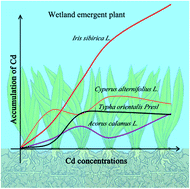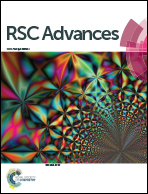Cadmium tolerance and accumulation characteristics of wetland emergent plants under hydroponic conditions†
Abstract
For the purpose of screening a potential Cd-hyperaccumulator for Cd-contaminated soil in paddy fields, four kinds of wetland emergent plants (Iris sibirica L., Acorus calamus L., Typha orientalis Presl and Cyperus alternifolius L.) were investigated for their cadmium tolerance and accumulation characteristics under hydroponic conditions. The physiological responses of plants, Cd concentration in tissues, Cd accumulation, bioaccumulation factor (BCF) and translocation factor (TCF) were investigated to evaluate the abilities of wetland emergent plants to absorb and accumulate Cd. In comparison with the other selected emergent plants, Iris sibirica L. has the strongest Cd-tolerance for the absence of Cd toxic symptoms and a Cd concentration as high as 127.3 mg kg−1 in shoots. Due to its large biomass, the Cd accumulation could reach up to 9.4 mg per plant in roots and 5.7 mg per plant in shoots, respectively. Iris sibirica L. possesses the highest TCF, and its BCF for Cd increased with increasing concentration of spiked Cd in the hydroponic solutions. The results indicate that Iris sibirica L. is a potential Cd-hyperaccumulator that may have a strong capacity for extracting Cd from Cd-contaminated paddy soils.



 Please wait while we load your content...
Please wait while we load your content...